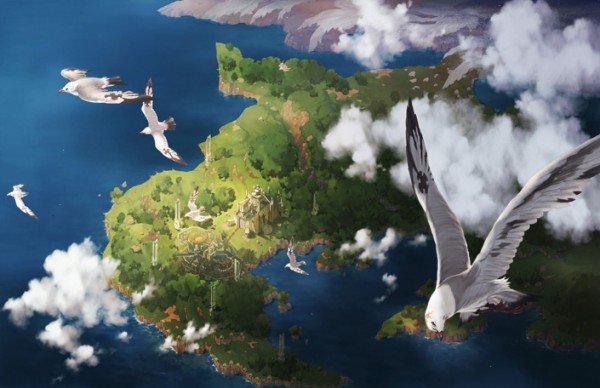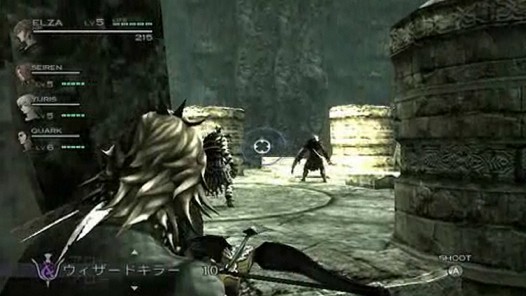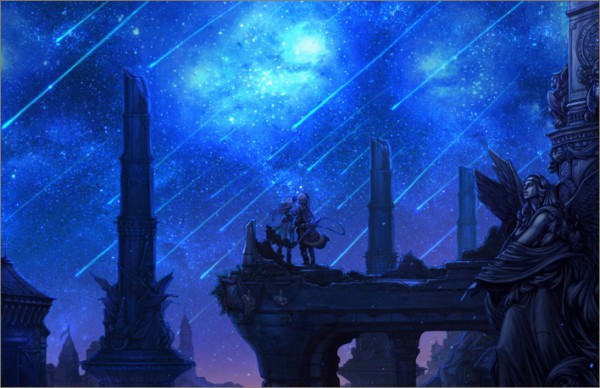
The Last Story (Wii)
The Last Story is an action role-playing game from developer Mistwalker. It was designed chiefly by one Hironobu Sakaguchi, famed for starting the Final Fantasy series. So wait…
Final Fantasy.
The Last Story.
I’m beginning to see a pattern here.
Since Mr. Sakaguchi no longer works for Square Enix and hence does not contribute to the Final Fantasy series anymore, the Last Story is his latest endeavor into JRPG’s that you might see out of Square Enix. You know, sexy protagonists with weirdo clothes, lavish and anachronistic settings, and themes about “fate”, “following your dreams”, and “unbreakable bonds”. This game is no stranger to the tropes of your mainstream JRPG’s. The Last Story is designed to be very safe in that regard, but this does not prevent the game from being creative and cool in its own way.
The Premise
The Last Story takes place in a land called Lazulis. It’s the capital city of what is understood to be a far-reaching and vibrant empire. It is run by the Arganan family, who has maintained power over Lazulis for generations. The plot begins in a period of intermittent war between the human Lazulis people and the reptilian humanoids called Gurak who live on a continent to the south. The war has raged on and off for centuries with no sign of stopping. As a result, the Lazulis realm has formed legions of knights, an impressive naval force, and a giant array of cannons around the capital city. This capital, Lazulis City, is home to our main characters.
Zael, the protagonist of the story, is a young man who grew up in a small town in Lazulis. His village was destroyed and his family killed by Gurak invaders when he was a child, and ever since then he has been driven to become an official knight of Lazulis and defend the helpless. Right now, though, he is a mercenary inhabiting pubs with his other mercenary compatriots:
Dagran (the leader), Yurick (offensive magic caster), Syrenne (flirtatious, alcoholic swordswoman), Mirania (bookish healer), and Lowell (ladies’ man and ice magic caster). The chemistry between all these characters is very natural and makes you really come to like them. The voice acting is wonderful; it lends them so much personality. These five and Zael take on jobs that the king’s knights would rather not. The game starts with a Gurak invasion that sets off the beginning of the game. It is here that we learn that the “life force” of Lazulis is draining (in other words, plants and animals are dying). We see our main antagonist, a Gurak leader named Zangurak who resembles Ganondorf far more than makes me comfortable.

- Turns out this island is actually a moving fortress. Surprised? Me neither.
Early in the game’s story, Zael runs into a new character named Lisa while walking through Lazulis city. They have a spirited chase from city guards before they are separated. Later on, Zael is in Lazulis Castle with his pals when he sees Lisa again. To his surprise, Lisa is really Lady Calista, a noble and heiress to the throne. For reasons that I will describe in detail later, Zael and Calista have some moments here and there, and eventually fall in love.
Main characters: check. Dire situation: check. Bad guy: check. Love interest: check. Well, I think we’re all set here for an adventure!
Game Play
In the Last Story, you control Zael as you lead your fellow mercenaries in battle, or simply walk through Lazulis City on your own. The city game play is pretty simple. There are no battles; the city is where you search for quests and meet new characters. Most of what you need to do here is acquire and upgrade weapons and equipment to use in battle. (More on this later.) Now the battle portions are really the meat of the Last Story.
The combat in this game starts off by the mercenaries entering a new area and analyzing the enemies within. The camera shows an over-head view of the battlefield, and you can see all the baddies, their names and levels, and their elemental designation. Sometimes, the enemies don’t know you’re there, so you have the chance to sneak around and find the best way to surprise your targets. Zael has a crossbow that you can use to snipe out enemies, too. Most of the time, you have to rush your enemies headfirst. That does not mean, however, that you don’t have to plan it out.

- “Ya got a forehead on ya like a coffee table.”
Each battle against multiple enemies plays out like this: sword-wielders run out front, and archers and mages sit in the back. You can’t just start attacking anyone with any weapon or spell, though. Many enemies have an elemental alignment. Elements in this game work within three pairs of conflicting icons: (Nature versus Star, Dark versus Holy, and Ice versus Fire) Attacking an Ice enemy with a Fire spell will do massive damage. However, attacking an Ice enemy with an Ice blade will do no damage, and may even heal them! No need to worry about mixing these pairs: Attacking a Nature enemy with a Dark attack won’t do anything special.
The problem with some of these large horde battles is the arena. In some battles, the place where you fight them is filled with a few too many obstacles and close quarters, making moving from here to there difficult. The game allows you to hop over your allies to make traversing the field of battle easier, but this doesn’t always make up for the fact that some stages are too claustrophobic for clean, fluid fighting.
This isn’t the problem, though, with monster battles. There are lots of single enemies that you take on in the Last Story, and this is where the game truly shines. Tackling this game’s many goliaths requires serious strategy of weapon choice, awareness of elements, and coordinating attacks and spells among your team mates. The ways that the Last Story lets you collaborate with your AI companions is very straightforward.
Say that Mirania casts a Healing spell. It will form a white circle on the ground around her. Any ally who steps in this circle will start healing. Now, if Zael uses his Gale sword ability and dashes through the Heal circle, the spell will dissipate and everyone on the team will be healed a certain percent of their total health. If Zael used the same Gale ability on Yurick’s Prominence fire spell circle, the spell would disappear and every ally would find an Armor Break aura on their weapons. The use of spells and Gale is the cornerstone to advanced battles. These fights are by far the best aspect of the game. In the last portion of the game, you are given a few hours of such battles one after the other. And it never gets old. Each fight is just as engaging and compelling as the last.
Seeing as this is a role-playing game, the Last Story is not complete without equipment. In this game, you find weapons and armor after battles and in chests which can be upgraded in Lazulis City shops in exchange for gold and other items. Very often weapons will have an elemental influence, or perhaps some armor will decrease the time taken to cast spells (or some other special effect).
The Last Story keeps true to RPG tradition with a leveling-up system. Throughout the first playthrough, I got Zael up to level 61. Most of the time, your characters will advance a level right after major battles, to the point where the game didn’t give you EXP; it just gave you another level. So in the Last Story, leveling up is more like a series of achievements than grinding numbers.
What makes this system a little awkward is that the story doesn’t always put every one of the main characters in battle with Zael. If Lowell didn’t join you on a certain quest for whatever reason, then everyone who went would level up two or three times. Later, if Lowell is traveling with everyone else, he will be that much weaker. This causes great gaps in stats among your party, and often a character might get killed again and again just because they were absent for a side-quest. The plot doesn’t allow for some characters to be in the party every time, so the game takes the Borderlands 2 route and gives the party members lagging behind extra EXP to compensate. Problem solved, I guess.
Moving back to the non-combat parts of the game, the Lazulis City is where you will spend a decent amount of time wandering around and finding things to do. Plenty of NPC’s will give you easy tasks, consisting almost entirely of finding certain items throughout the streets and bringing them back. In fact, I think that’s what all quests in the city are like. When you think about it, Lazulis City is less of a bastion of peaceful side-quests used to add depth and make the world more detailed. It’s more of a hub area where you acquire tools and items for use in battle after spending money or running to and fro.
It’s a giant convenience store, not a real cityscape. It’s all economy, no culture. Colony 9 in Xenoblade Chronicles or Hyrule Castle Town in Legend of Zelda will give you things to help your journey but also tidbits of people’s lives and useless quests to do just because the opportunity is there. That makes the towns/cities feel alive, like there are real people living in these fantastic places. Lazulis City lacks this. Yes, it looks wonderful. The atmosphere is great and the animations and very detailed. But there is nothing in the game play that makes you feel like you are interacting with something larger.
Presentation
The visuals of this game are exquisite. Textures and colors look natural without being too eye-catching or obnoxious. When you are in enemy territory, for example, everything looks dark and grim, as it should to establish the atmosphere. When you are back in Lazulis Castle, the colors are pale and everything looks very sterile and synthetic. This lets your brain know that while everything is in order in Lazulis, the life is still draining from the earth. It’s the subtle things like that that make the world design so effective.
Character models are pretty well detailed, but it’s their artistic design that sets them apart. Everyone from knights to street-dwellers look like something from late 19th century Europe, but at the same time, their hair and faces still look like they’re torn from the pages of a manga. As an artist, I mean that with the highest amount of respect. The concept art to this game is incredible. Each of the main named characters feels unique and endowed with their own personality. Even the cloned NPC’s in Lazulis City look and move with some lovely animations (especially when you bump into them Assassin’s Creed style).

- Where Zael and Calista fall in love. It just screams “love sequence”!
There are times when the graphics of an area in the Last Story could rival those of Xbox 360 or PS3 games. Stargazer’s Tower is the best example of this, as are the heavily-detailed CGI cutscenes that show major events in the plot. But it’s not the visuals that really build up this game’s presentation. It’s the soundtrack. The soundtrack created by one Nubuo Uematsu. Remember him?
Needless to say, the music to the Last Story is spectacular. Every track from the main menu theme to songs in cutscenes is beautiful. There’s not much else I can think to say. It’s the music that really pulls the atmosphere together.
Other Notes
Here I’d like to discuss the plot and characters more. You see, the Last Story is a game that tries to tell a serious and entertaining story, which is not something that video games do all the time. It doesn’t always hit the mark, though.
Zael x Calista:
When I first saw the scene where the main couple first meets, I rolled my eyes. At first it seemed like giving the main character a love interest was just something you do when writing a young man on a journey of self-discovery. Very often, love stories are done in vain. As the story goes on, and you learn more about Zael and more about Calista’s life, you learn that they really have a reason for wanting to be together. His desire to be closer to everything official and royal reacts with Calista’s need to be free from her nobility and live life on her own terms. At the end of the day, this love story isn’t just placed here out of convention or a benign attempt at emotional connection with the player. From a character-building perspective, it makes sense.
Deus Ex Machina:
There are far too many instances to count in the Last Story in which the following happens. The party is split up. They all take alternate routes to go deeper into dangerous territory. Oh no! Zael encounters trouble and he may die! Don’t you worry, though! His friends appear at the perfect moment to help him out!
Seriously, this happens so many times throughout the game that it really takes you out of the moment. When a situation seems insurmountable and beyond hope, and some sort of unexpected force beyond anyone’s prediction comes from on high to save the day, this is called a Deus Ex Machina. To have Zael’s friends come from nowhere to save him once is cool. To have this happen again and again will make this heroism lose its edge.
Narration:
Here’s a weird thing about this game. In between cutscenes and game play, the screen turns black and white text appears. Then, a voice-over will narrate this text, which explains what just happened in the story, and what is going to happen now as a result. These narrations are lines of text that you might read in a book, very simple and very clear. My understanding is that this “Last Story” wants to tell a story like you would read in a book, so narrated lines of text to explain events and transition between scenes would help drive this storybook theme along, right?
Well, no. It doesn’t really work like that. What these game designers didn’t take into account is that, like film, video games are an audio-visual medium. In a movie, you show transitions and explain events by showing them in action or show their consequences on the characters. It’s far more effective to show the viewer what they need to know instead of just telling them. The viewer will put everything together themselves. In a book, though, the reader needs to be told everything because text is all they have.
The problem here is that video games are audio-visual like movies, not based in mere words like books. To explain the world and what is going on should be done through cut scenes and stretches of game play, not through narration. Sure, you can go to the library in Lazulis Castle and read up on the mythology of the Last Story. But when it comes to the main events of the story that are happening before your eyes, we shouldn’t have to be told what is going on; we should see it and interact within it. The Last Story gets caught up in its creative ways of telling its story that it forgets that it is, above all, a video game and needs to exposit and develop the plot like a video game should.
Conclusion
After over thirty hours of game play invested into the Last Story, I am happy to report that this Operation Rainfall title finally published outside Japan is in fact a quality game. If you enjoy Final Fantasy, Kingdom Hearts, and a lot of other role-playing games filled with sexy hair, ridiculous outfits, and corny themes at inappropriate times, then the Last Story is a necessity for you. It’s a great JRPG among JRPG’s. If you’re like me and you just like playing original, creative video games, then you will still enjoy this game.
The fact is that I can understand Nintendo’s logic behind not publishing the Last Story in North America. This game only sold just over 128,000 units over here, which isn’t bad but it certainly isn’t what it deserves. North America isn’t the best place for selling games like this. It’s a different market than in Japan, and I can understand Nintendo’s hesitance. I am oh so glad that XSeed games put up the money to publish this.
The presentation is rock solid, with some excellent visuals (especially for the Wii) and one of the best soundtracks I’ve ever heard. There are glitches here and there, but they are few and tiny. The AI is very good. Your allies never get lost or stuck, and the city folk NPC’s do exactly what they should. Voice acting is spot-on and chock full of personality. Sure, the story has its hiccups (if you don’t mind anime tropes). There are a number of things that don’t make complete sense, like the writers didn’t think it through all the way, but all-in-all the story is a noble effort to be creative while still holding fast the tradition.
4/5
Would Certainly Recommend
Equip your crossbow/gun/sword and zip up your gratuitous zippers! Our forums are ready for your perusal! Drop a comment or two!
0 Comments
This post has been left all alone with no comments. Don't leave it lonesome - give it some company with a comment.